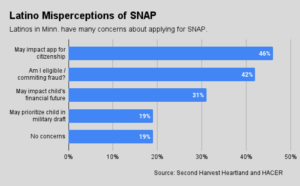At just over one million meals served, the federal after-school meals program, largely funded through the Child and Adult Care Food Program (CACFP), does not have near the reach of school lunch or breakfast, but diligence and creativity on the part of some food banks is helping to raise its profile.
St. Mary’s Food Bank in Phoenix began aggressively broadening its outreach in after-school meals about a year ago, building upon an already established program. Now it delivers meals to about 8,000 students at 160 sites, said Jose Urteaga, community engagement manager. In a webinar sponsored by Food Research and Action Center and in a follow-up interview, Urteaga gave advice to other food banks that might want to support after-school meals:
Be strategic in your outreach — St. Mary’s Food Bank wanted to be more proactive in bringing its program to schools, but didn’t want to be haphazard about it. “You can’t just go everywhere,” Urteaga said. To assess underserved areas, St. Mary’s used data from the state to identify all of the public and charter schools in Arizona’s largest and most populous county, as well as an ever-evolving list of non-school sites where children gather, such as YMCAs and Boys & Girls Clubs.

The team then contacted every single school to find out about their after-school programs, whether food was already served, and how the food bank could potentially partner. The process took about seven months, and now the food bank is expanding its due diligence to other areas and non-school sites.
Using mapping software, Urteaga also identified the highest areas of food insecurity and overlaid that with a map of all the places it currently provides services through agencies, kids cafes, backpack programs and so on. Plus, it identified food distribution sites that are not affiliated with St. Mary’s, recognizing that it is not the only entity fighting hunger and that areas could become oversaturated with services. The overall approach “made it easier to identify areas where we don’t do enough,” Urteaga said.
Make sure kids want to eat the food — St. Mary’s Food Bank took nutrition, culture and even possible allergies into account when creating its after-school menus. Its 7,000 cold meals, which typically include a sandwich, a fruit, a vegetable and milk, are nut-free, featuring sunflower seed butter instead of peanut butter. “It’s a big hit,” Urteaga said of the sunflower flavor. For the 1,000 or so hot meals also served daily, the food bank took care to develop menus with a wide variety of culturally appropriate food. Entrees, for example, include sweet and sour chicken, pork carnitas and chicken cacciatore, all prepared with fresh ingredients.
Be creative in your staffing — To help assemble its cold meals, St. Mary’s Food Bank takes advantage of a volunteer staff of about 80 retirees. It also has a relationship with local law enforcement, which gives it a pipeline to inmates who can help. The hot meals are prepared through its Community Kitchen program, which offers hands-on food service training for people with barriers to employment. The preparation of after-school meals has become a favorite part of the program for trainees, Urteaga said, because they know the food is going to kids, many of whom have backgrounds similar to their own.
Be flexible — While most schools and after-school programs are enthusiastic about tapping into a free-food program, some may already be serving a snack and getting reimbursed for it, making them reluctant to give up a revenue stream. Urteaga advises working with such schools on innovative solutions. It is piloting a program, for example, in which the food bank serves a meal immediately after school, then the school serves a snack at the end of the program. “That only works if the school is willing to do two servings, and if there is enough time — at least two hours — to serve two times,” Urteaga said.
Rural communities, which often lack funding for after-school programs, can require another level of flexibility. In these high-need communities, Urteaga advises against going in “with a one-track mind and trying to make CACFP fit.” In such cases, an on-site school pantry or a mobile pantry every two weeks might be a better solution.
Don’t hesitate — In finding partners to work with in the feeding community, it’s hard to find a wrong way to do it, Urteaga said. “There is no wrong way,” he added. “Just do it.”









